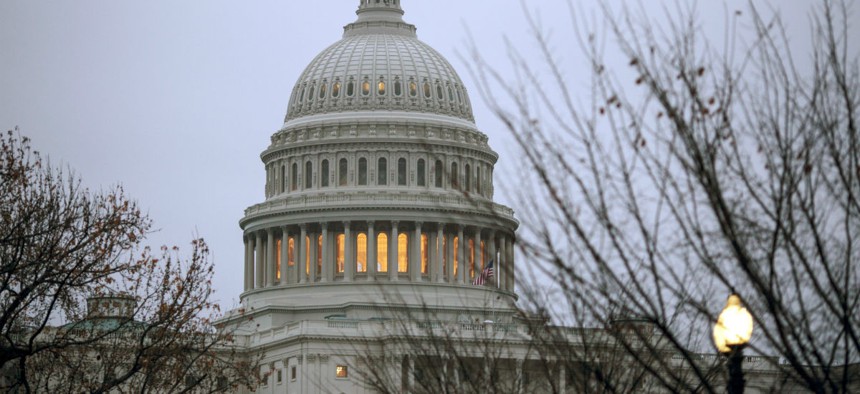
Lawmakers late Thursday passed a continuing resolution to keep government funded through Dec. 22. J. Scott Applewhite/AP
Congress Passes Two-Week Spending Bill, but Shutdown Fears Mount
Immigration issues could derail negotiations to fund the government for the rest of fiscal 2018.
Congress has approved a measure to keep the federal government open for two weeks, although the prospect of a longer-term spending deal remains unclear.
The Senate voted 81-14 for the stopgap spending package (H.J. Res. 123), which continues current spending levels until Dec. 22 and provides a temporary authorization for the Children’s Health Insurance Program until the end of 2017. Senate passage came Thursday evening after House lawmakers, voting mostly along party lines, approved the bill by a 235-193 vote.
President Trump signed the continuing resolution on Friday.
Democrats in the House mostly opposed the measure because they said Republicans have not engaged in the good faith negotiations required to this point.
Congress had until Friday night to pass a spending package in order to avoid a government shutdown. GOP leaders endorsed a two-week continuing resolution in order to give lawmakers more time to negotiate appropriations for all of fiscal 2018, as well as to reach a deal to increase statutorily mandated spending caps. Without congressional action, a long-term continuing resolution would allocate money above the caps set by the 2011 Budget Control Act and trigger another round of sequestration as early as January.
“Democrats have said all year that there must be a deal to raise spending caps in order to enact appropriations bills,” said Rep. Louise Slaughter, D-N.Y., ranking member of the House Appropriations Committee. “Instead of heeding that advice, the majority once again is stumbling from crisis to crisis, trying to fund the government two weeks at a time.”
House Rules Committee Chairman Rep. Rob Woodall, R-Ga., said the two-week measure is necessary in order to allow the Senate to get its fiscal house in order.
“We passed all 12 of our appropriation bills ahead of schedule,” he said. “I’m sorry that we’re here, but this is the best circumstance we can create to allow the Senate to succeed. It requires a bipartisan majority to succeed, so let’s not pretend this is a partisan problem—it’s an American challenge.”
Even as the two-week CR moves forward, the fate of a long-term spending deal remains uncertain. Both parties remain at odds over how to increase the defense and non-defense spending caps.
According to the Huffington Post, the Republican leadership offered to fund defense at $54 billion above sequester-mandated levels for 2018 and to fund nondefense at $34 billion above sequester levels. But Democrats demanded parity between defense and non-defense spending and that both sides be funded at $54 billion above sequester levels.
Additionally, Democrats have insisted they would not sign on to any spending package that does not include a number of policy provisions, including a long-term CHIP authorization, codification of the Obama administration’s Deferred Action for Childhood Arrivals program, as well as measures to stabilize health insurance markets like mandating that the White House continue to pay premium cost sharing reductions for plans on the Obamacare exchanges.
But on Thursday, ahead of a meeting between Trump and congressional leaders, the White House appeared to throw cold water on Democrats’ policy demands.
“The president has said that with DACA, he wants to make sure we have responsible immigration reform, including the border wall, as laid out in our priorities and principles on the issue,” said White House Press Secretary Sarah Huckabee Sanders. “So that’s something that would have to be part of that discussion."
After the meeting between Trump and congressional leaders, the White House said the meeting was "constructive," according to CBS News' Mark Knoller, but reiterated DACA provisions should be handled at another time.
This post was updated to reflect the Senate's vote on the bill and again after President Trump signed the bill.
Sign up for GovExec newsletters and alerts and download our app to stay informed.







